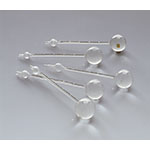Set of twenty-six matching thermometers divided into fifty degrees, one of the many thermometric scales adopted by the Accademia del Cimento. The graduations consist of small enamel dots, black for single degrees, white for ten degrees. The thermometers end in spherical bulbs and carry white enamel markings on their small upper bulbs. The thermometric liquid is acquarzente. Invented by Grand Duke Ferdinand II de' Medici, fifty-degree thermometers were generally used to measure the variations in heat and cold of the air, both outdoors and indoors. The academicians made extensive use of the instrument, chiefly for meteorological observations: the advantage of these thermometers was that their readings were comparable with one another, even though they were not the most sensitive.










